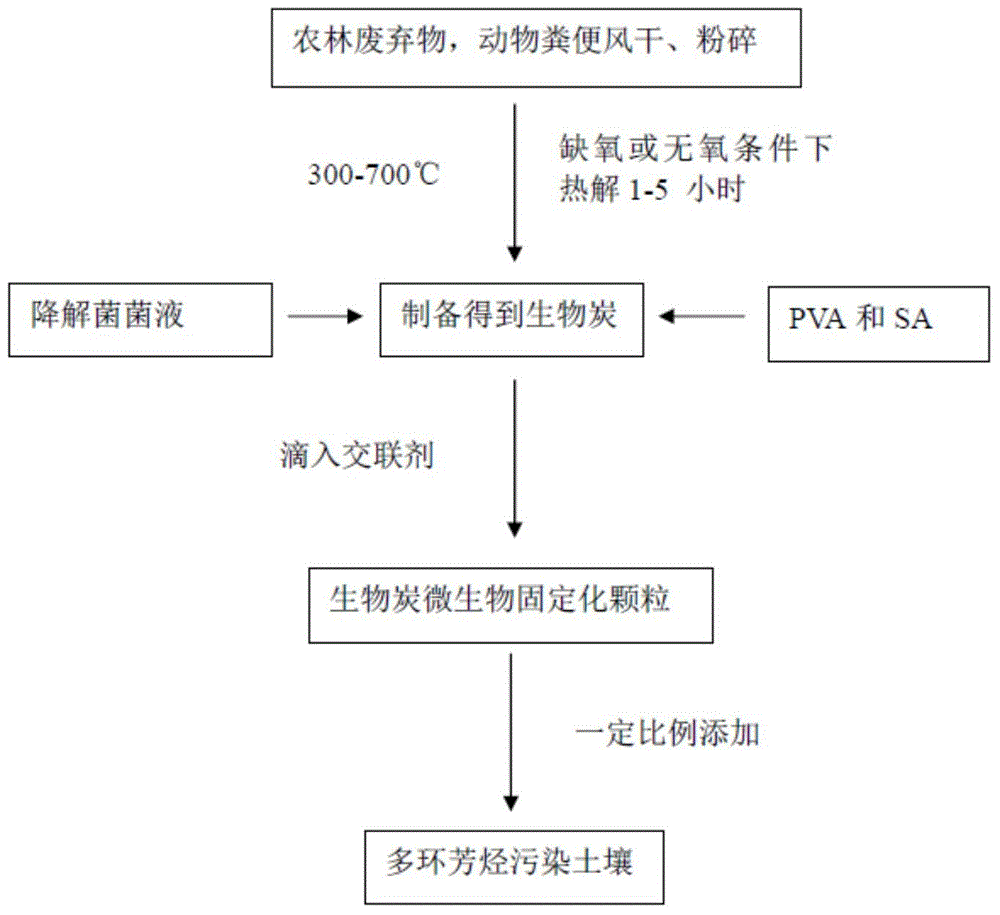Preparation, application and usage method for biocarbon-immobilized composite pollution-degrading bacterium particle
A technology of complex pollution and degrading bacteria, applied in the restoration of contaminated soil, etc., can solve the problems of failure and inability to fundamentally eliminate soil pollution, etc., achieve low cost, enhanced in-situ repair effect duration, and good effect
- Summary
- Abstract
- Description
- Claims
- Application Information
AI Technical Summary
Problems solved by technology
Method used
Image
Examples
Embodiment 1
[0034] The technological process of biochar immobilization compound pollution degrading bacteria repairing polycyclic aromatic hydrocarbon contaminated soil method in this implementation example is as follows figure 1 As shown, the specific steps of using rice husk biochar to treat PAH-contaminated soil are as follows:
[0035] Preparation of biochar: under the condition of 350°C, use rice husks to dry and pulverize under anaerobic conditions, use a carbonization furnace to pyrolyze for 4 hours to prepare biochar, grind, and pass through an 80-mesh sieve;
[0036] Selection of degrading microorganisms: the selected strain was Enterobacter cloacae strain CCTCC NO:M 2012240, and the strain used was a heavy metal-resistant polycyclic aromatic hydrocarbon degrading strain purchased from China Center for Type Culture Collection.
[0037] Preparation of biochar-immobilized microorganisms: add 20g PVA and 2g SA to 200mL distilled water and soak overnight, then stir at room temperatur...
Embodiment 2
[0051] The technological process of the biochar-immobilized microbial remediation method for PAH-contaminated soil in this implementation example is as follows: figure 1 As shown, the specific steps of using cow dung biochar to treat PAH-contaminated soil are as follows:
[0052] Preparation of biochar: At a temperature of 350°C, dry the pulverized material with cow dung under anaerobic conditions, use a carbonization furnace to pyrolyze for 4 hours to prepare biochar, grind it, and pass through an 80-mesh sieve;
[0053] Selection of degrading microorganisms: the selected strain was Enterobacter cloacae strain CCTCC NO:M 2012240, and the strain used was a heavy metal-resistant polycyclic aromatic hydrocarbon degrading strain purchased from China Center for Type Culture Collection.
[0054] Preparation of biochar-immobilized microorganisms: add 20g PVA and 2gSA to 200mL distilled water and soak overnight, then stir at room temperature for 15 minutes, heat to 95°C through a wat...
Embodiment 3
[0067] This embodiment is a variation example of embodiment 1, and the specific technical scheme is the same as that of embodiment 1, and the changes only lie in:
[0068] (1) In the preparation of biochar, the temperature is 300° C., the time is 5 hours, and the filter adopts a 100-mesh sieve;
[0069] (2) In biochar-immobilized microorganisms, the concentration of PVA is 5% (m / v), and the concentration of SA is 0.5% (m / v); the mass ratio of bacteria to carrier sol is 1:100; crosslinking agent CaCl in solution 2 The concentration is 20g / L;
[0070] (3) The weight ratio of biochar-immobilized compound pollution-degrading bacteria particles to polycyclic aromatic hydrocarbon compound-contaminated soil in coking plant is 0.5:100.
PUM
 Login to View More
Login to View More Abstract
Description
Claims
Application Information
 Login to View More
Login to View More - Generate Ideas
- Intellectual Property
- Life Sciences
- Materials
- Tech Scout
- Unparalleled Data Quality
- Higher Quality Content
- 60% Fewer Hallucinations
Browse by: Latest US Patents, China's latest patents, Technical Efficacy Thesaurus, Application Domain, Technology Topic, Popular Technical Reports.
© 2025 PatSnap. All rights reserved.Legal|Privacy policy|Modern Slavery Act Transparency Statement|Sitemap|About US| Contact US: help@patsnap.com



